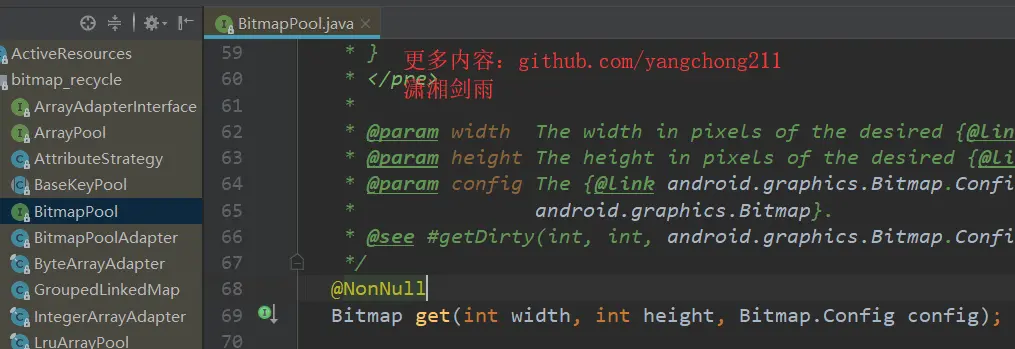Android Glide 对象池
01.对象池Pools优化频繁创建和销毁类
优化点
- 对开销较大的 Bitmap 进行了复用,就连为了复用Bitmap时重复申请的Key对象都进行了复用,尽可能的减少了对象的创建开销,保证了应用的流畅性。
对象池作用
- 在某些时候,我们需要频繁使用一些临时对象,如果每次使用的时候都申请新的资源,很有可能会引发频繁的 gc 而影响应用的流畅性。这个时候如果对象有明确的生命周期,那么就可以通过定义一个对象池来高效的完成复用对象。
glide频繁请求图片
- 比如Glide中,每个图片请求任务,都需要用到类。若每次都需要重新new这些类,并不是很合适。而且在大量图片请求时,频繁创建和销毁这些类,可能会导致内存抖动,影响性能。
- Glide使用对象池的机制,对这种频繁需要创建和销毁的对象保存在一个对象池中。每次用到该对象时,就取对象池空闲的对象,并对它进行初始化操作,从而提高框架的性能。
代码如下所示
1
2
3
4
5
6
7
8
9private final Map<String, Bitmap> cache = new HashMap<>()
private void setImage(ImageView iv, String name){
Bitmap b = cache.get(name);
if(b == null){
b = loadBitmap(name);
cache.put(name, b);
}
iv.setImageBitmap(b);
}多条件 Key
- 例如上述代码就简单的通过 HashMap 缓存了 Bitmap 资源,只有在缓存不存在时才会执行加载这个耗时操作。但是上面的缓存条件十分简单,是通过图片的名字决定的,这很大程度上满足不了实际的需求。所以我们就需要定义一个 Key 对象来包含各种缓存的条件,例如我们除了图片名字作为条件,还有图片的宽度,高度也决定了是否是同一个资源,那么代码将变成如下:
1
2
3
4
5
6
7
8
9
10
11
12
13
14
15
16
17
18
19
20
21
22
23
24
25
26
27
28
29
30
31
32
33
34
35
36
37
38
39
40
41
42
43
44
45
46
47
48
49
50
51
52
53
54
55
56
57
58
59
60
61private final Map<Key, Bitmap> cache = new HashMap<>();
private void setImage(ImageView iv, String name, int width, int height){
Key key = new Key(name, width, height);
Bitmap b = cache.get(key);
if(b == null){
b = loadBitmap(name, width, height);
cache.put(key, b);
}
iv.setImageBitmap(b);
}
public class Key {
private final String name;
private final int width;
private final int heifht;
public Key(String name, int width, int heifht) {
this.name = name;
this.width = width;
this.heifht = heifht;
}
public String getName() {
return name;
}
public int getWidth() {
return width;
}
public int getHeifht() {
return heifht;
}
@Override
public boolean equals(Object o) {
if (this == o) {
return true;
}
if (o == null || getClass() != o.getClass()) {
return false;
}
Key key = (Key) o;
if (width != key.width) {
return false;
}
if (heifht != key.heifht) {
return false;
}
return name != null ? name.equals(key.name) : key.name == null;
}
@Override
public int hashCode() {
int result = name != null ? name.hashCode() : 0;
result = 31 * result + width;
result = 31 * result + heifht;
return result;
}
}key值的复用
- 虽然可以支持多条件的缓存键值了,但是每次查找缓存前都需要创建一个新的 Key 对象,虽然这个 Key 对象很轻量,但是终归觉得不优雅。gilde源码中会提供一个 BitmapPool 来获取 Bitmap 以避免 Bitmap 的频繁申请。而 BitmapPool 中 get 方法的签名是这样的:

- Bitmap 需要同时满足三个条件(高度、宽度、颜色编码)都相同时才能算是同一个 Bitmap,那么内部是如何进行查找的呢?需要知道的是,BitmapPool 只是一个接口,内部的默认实现是 LruBitmapPool
看LruBitmapPool中get方法
- 注意重点看这行代码:final Bitmap result = strategy.get(width, height, config != null ? config : DEFAULT_CONFIG);
- strategy 是 LruPoolStrategy 接口类型,查看其中一个继承该接口类的 get 方法的实现
1
2
3
4
5
6
7
8
9
10
11
12
13
14
15
16
17
18
19
20
21
22
23
24
25
26
27
28
29
30
31
32
33
34
35
36
37
38
39
40
41@Override
@NonNull
public Bitmap get(int width, int height, Bitmap.Config config) {
Bitmap result = getDirtyOrNull(width, height, config);
if (result != null) {
// Bitmaps in the pool contain random data that in some cases must be cleared for an image
// to be rendered correctly. we shouldn't force all consumers to independently erase the
// contents individually, so we do so here. See issue #131.
result.eraseColor(Color.TRANSPARENT);
} else {
result = createBitmap(width, height, config);
}
return result;
}
@Nullable
private synchronized Bitmap getDirtyOrNull(
int width, int height, @Nullable Bitmap.Config config) {
assertNotHardwareConfig(config);
// 对于非公共配置类型,配置为NULL,这可能导致转换以此处请求的配置方式天真地传入NULL。
final Bitmap result = strategy.get(width, height, config != null ? config : DEFAULT_CONFIG);
if (result == null) {
if (Log.isLoggable(TAG, Log.DEBUG)) {
Log.d(TAG, "Missing bitmap=" + strategy.logBitmap(width, height, config));
}
misses++;
} else {
hits++;
currentSize -= strategy.getSize(result);
tracker.remove(result);
normalize(result);
}
if (Log.isLoggable(TAG, Log.VERBOSE)) {
Log.v(TAG, "Get bitmap=" + strategy.logBitmap(width, height, config));
}
dump();
return result;
}然后看一下SizeConfigStrategy类中的get方法
- 看一下下面注释的两行重点代码。同样也需要一个专门的类型用来描述键,但是键result居然是也是从一个对象池keyPool中获取的。
- 可以看到 Key 是一个可变对象,每次先获取一个Key对象(可能是池中的,也可能是新创建的),然后把变量初始化。但是大家知道,HashMap 中的 Key 不应该是可变对象,因为如果 Key的 hashCode 发生变化将会导致查找失效,那么这里是如何做到 Key 是可变对象的同时保证能正确的作为 HashMap 中的键使用呢?
1
2
3
4
5
6
7
8
9
10
11
12
13
14
15
16
17
18
19
20
21
22
23
24
25
26
27
28
29
30
31
32
33
34
35
36
37
38
39
40
41
42
43
44
45
46@Override
@Nullable
public Bitmap get(int width, int height, Bitmap.Config config) {
int size = Util.getBitmapByteSize(width, height, config);
Key bestKey = findBestKey(size, config);
//第一处代码
Bitmap result = groupedMap.get(bestKey);
if (result != null) {
decrementBitmapOfSize(bestKey.size, result);
result.reconfigure(width, height,
result.getConfig() != null ? result.getConfig() : Bitmap.Config.ARGB_8888);
}
return result;
}
private Key findBestKey(int size, Bitmap.Config config) {
//第二处代码
Key result = keyPool.get(size, config);
for (Bitmap.Config possibleConfig : getInConfigs(config)) {
NavigableMap<Integer, Integer> sizesForPossibleConfig = getSizesForConfig(possibleConfig);
Integer possibleSize = sizesForPossibleConfig.ceilingKey(size);
if (possibleSize != null && possibleSize <= size * MAX_SIZE_MULTIPLE) {
if (possibleSize != size
|| (possibleConfig == null ? config != null : !possibleConfig.equals(config))) {
keyPool.offer(result);
result = keyPool.get(possibleSize, possibleConfig);
}
break;
}
}
return result;
}
@VisibleForTesting
static class KeyPool extends BaseKeyPool<Key> {
Key get(int width, int height, Bitmap.Config config) {
Key result = get();
result.init(width, height, config);
return result;
}
@Override
protected Key create() {
return new Key(this);
}
}然后看一下groupedMap的代码
- 在查找时,如果没有发现命中的值,那么就会创建新的值,并将其连同 Key 保存在 HashMap 中,不会对 Key 进行复用。而如果发现了命中的值,也就是说 HashMap 中已经有一个和当前 Key 相同的 Key 对象了,那么 Key 就可以通过 offer 方法回收到了 KeyPool 中,以待下一次查找时复用。
1
2
3
4
5
6
7
8
9
10
11
12
13
14@Nullable
public V get(K key) {
LinkedEntry<K, V> entry = keyToEntry.get(key);
if (entry == null) {
entry = new LinkedEntry<>(key);
keyToEntry.put(key, entry);
} else {
key.offer();
}
makeHead(entry);
return entry.removeLast();
}